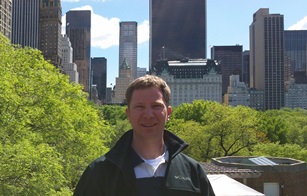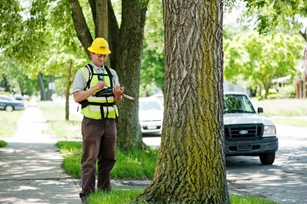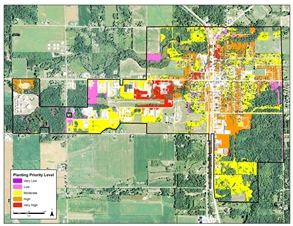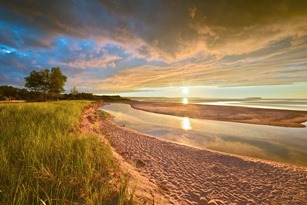Urban, community forests add much to Michigan’s scenic and economic landscape
It’s been said the best time to plant a tree was 20 years ago, and the second best time is today.
Looking at the Michigan Department of Natural Resources’ long record of forest protection and management on state forest land and in plenty of urban areas, it’s a theory clearly subscribed to by many DNR staff and partners.
And for good reason.
 “Whether they grow in public forests, private woodlots or right outside your front door, trees are working 24 hours a day, seven days a week, to provide us with important ecological, economic and social benefits,” said Kevin Sayers, manager of the DNR’s Urban and Community Forestry Program. “Whether they grow in public forests, private woodlots or right outside your front door, trees are working 24 hours a day, seven days a week, to provide us with important ecological, economic and social benefits,” said Kevin Sayers, manager of the DNR’s Urban and Community Forestry Program.
Sayers said most Michigan residents hear the word forest and immediately think of the “up north” woods. That’s not surprising, considering Michigan is blessed with enviable trees and forests that cover nearly 55 percent of the state.
Beyond that traditional notion of forests, though, there are other trees and related natural resources in the “built environment” that are commonly referred to as urban and community forest.
Trees for people
Simply put, these are trees for people and they often go unnoticed, even though they’re among the most valuable assets a community can have.
“This is where trees and people intertwine,” Sayers said. “It’s where society benefits most directly and immediately from their presence.
“Think about the many vibrant communities – Ann Arbor, Birch Run, Glen Arbor, Royal Oak and Ironwood, to name just a few – whose very character and identity are much defined by trees.”
Sayers says the trees in these more urbanized areas do much more than provide pretty backdrops for day-to-day living.
Of Michigan’s nearly 10 million residents, almost 80 percent live in urbanized areas.
Sayers says studies have estimated more than 100 million trees exist in these areas and provide an average of 22 percent tree cover. Even more compelling, nearly 15 percent of the total statewide tree cover is found in urban and community lands.
Understanding the benefits
 Beyond the obvious aesthetics, community trees also improve an area’s environmental quality and its quality of life. Until recently, these benefits weren’t easily measured or understood. Today, after significant effort and investment, the relationship among trees, people and the environment is well established. Beyond the obvious aesthetics, community trees also improve an area’s environmental quality and its quality of life. Until recently, these benefits weren’t easily measured or understood. Today, after significant effort and investment, the relationship among trees, people and the environment is well established.
“In the past 10 to 15 years we’ve seen the development of research tools such as i-Tree (www.itreetools.org) and remote sensing that have greatly expanded our understanding of tree benefits,” Sayers said. “Community trees have proven to be an important resource worth our attention, investment and long-term planning.”
Nationally, research has shown healthy trees can add between 7 and 11 percent to the value of a property, and homes with treed lots sell faster than those without trees. In business districts, customers spend up to 11 percent more and prefer to shop in areas where trees and landscaping are attractive and well maintained.
“Think about the ecological boosts, too,” Sayers said. “Noise reduction, oxygen, erosion control, reduced storm water runoff, better water quality, habitat for wildlife – all of these are made possible with healthy, thriving trees.”
These are exactly the kind of benefits the DNR’s Urban and Community Forestry Program and partners work to bring to many areas of the state.
Assessing the value
In Detroit, a full inventory of trees on all city streets is nearly completed. Once that data collection is finished, city leaders will have a clearer understanding of their landscape and be better equipped to proactively manage it.
Todd Mistor, superintendent with the city’s forestry and ground maintenance, called Detroit’s street tree inventory a “transformative process.”
“I started working with the city of Detroit’s forestry division in 2007,” Mistor said. “At that time, information about our urban forest consisted of resident complaints, handwritten notes and anecdotes from long-time employees.”
Not a great starting point, but in 2011 arrived an opportunity for the city to partner with the U.S. Forest Service and the DNR to start conducting a tree inventory with a particular focus on recording insect presence and damage.
“A lot of good data was collected about each tree in that initial inventory phase, and evaluation of that data set sparked discussions about what data would actually be useful,” Mistor said. “Paring down the data being collected helped us maximize the efficiency of the process, and more phases of the inventory were completed.”
 But then diminishing financial resources significantly limited the city’s ability to do much meaningful work with the data it did have, and that data languished for a few years. Add in a bankruptcy for the city of Detroit, and the urban forestry effort was placed on the back burner. But then diminishing financial resources significantly limited the city’s ability to do much meaningful work with the data it did have, and that data languished for a few years. Add in a bankruptcy for the city of Detroit, and the urban forestry effort was placed on the back burner.
“Later, as the city emerged from bankruptcy proceedings, it was evident there was a need for different management practices,” Mistor said. “The street tree inventory that had been sitting dormant was reassessed and gave new life and strength to our planning process.”
Mistor said contemporary management practices and resource allocation are data-driven – a far cry from the decades-old approach of having massive amounts of labor available for whatever may come along.
“Our street tree inventory data has been successful in securing funding to address critical needs,” he said. “It has helped us begin the process of strategically converting Detroit’s urban forest from a neglected liability to an asset that will enhance quality of life for current residents and aid in attracting new ones.”
Supporting smaller communities
Farther north in the Saginaw Bay watershed, the DNR has partnered with the cities of Au Gres and Standish and ReLeaf Michigan on an effort (funded by the Great Lakes Restoration Initiative) to analyze the area’s tree canopy and its overall benefit in managing storm water runoff.
Think of how an opened umbrella offers shelter in a downpour. Tree canopy – with leaves and bark that retain a lot of water – works much the same way, allowing some rain time to evaporate and slowing down the rest on its way to the ground.
Lee Mueller, with Davey Resource Group (a division of the Davey Tree Expert Company), said that while his company
 has completed many similar projects across the United States, this is the first time they’ve been involved in a project that touches one watershed and is within rural communities. has completed many similar projects across the United States, this is the first time they’ve been involved in a project that touches one watershed and is within rural communities.
“Community forestry often concentrates on impacts to large, populated communities,” he said. “But Michigan's smaller communities have trees, too.
“Smaller communities also often have little forestry-specific expertise. This tree canopy analysis project represents a significant opportunity to expose two of Michigan's communities to forestry best practices, while delivering tools that will help them protect, enhance and expand their community forest for years to come.”
Helping habitat, wildlife
Sayers said the DNR’s urban forestry and forest stewardship program efforts extend north all the way to the Lake Superior shoreline. Here another Great Lakes Restoration Initiative project – this one with coastal, habitat and collaborative benefits – is getting started through the efforts of the Superior Watershed Partnership and the city of Marquette.
The goal? Improving the near-shore health of Lake Superior and reducing runoff pollution in the Dead River watershed by restoring area riparian buffers – vegetated areas near a stream, which help shade and partially protect the stream from the effects of adjacent land uses.
First, a team of young adults with the SWP Great Lakes Conservation Corps will oversee a prioritized planting of native tree species.
 Carl Lindquist, executive director of the Superior Watershed Partnership and Land Trust, said this project also will complement ongoing efforts to restore coastal wetlands, create resilient beaches and more. Carl Lindquist, executive director of the Superior Watershed Partnership and Land Trust, said this project also will complement ongoing efforts to restore coastal wetlands, create resilient beaches and more.
“In addition to improved water quality, the area will see improved habitat conditions for wildlife including migratory birds and important pollinator species,” he said.
“What’s happening here is an innovative approach to fostering increased, strategic forest management between the cities and townships and neighboring rural forest landowners.”
Every tree counts
Sayers said with the nation’s celebration of Arbor Day right around the corner (April 29), these important forestry efforts are timely, encouraging and great news for Michigan’s communities of all sizes.
“Across the country there is a growing appreciation of trees and the realization that a good tree care program is an investment for the future,” he said.
Both individually and collectively, Sayers said each of us can help trees grow and continue to provide the things we need and value, like oxygen, shade and peace of mind. Contact your city forester, beautification committee or state forester’s office for more information.
“And,” Sayers added, “don’t forget to step outside your front door now and then, just to enjoy the trees.”
Learn more about the DNR’s Urban and Community Forestry Program at www.michigan.gov/ucf or contact Kevin Sayers at 517-284-5898.
Watch a short video describing how Michigan’s forests enhance our everyday lives.
Catch upcoming stories by subscribing to free, weekly “Showcasing the DNR” articles. Previous articles are available at www.michigan.gov/dnr-stories.
/Note to editors: Contact: Kevin Sayers, 517-284-5898 or John Pepin, 906-226-1352. Accompanying photos are available below for download. Suggested captions follow. Credit: Michigan Department of Natural Resources (except where otherwise noted).
Detroit_tree_inventory_arborist.jpg – A city of Detroit arborist collects information on the trees along city streets, part of a larger data-driven effort to help the city better understand and manage its urban forest landscape.
Au Gres and Standish_planting_priority_map.jpg – Maps illustrating the tree-planting priorities for the cities of Au Gres and Standish in their effort to analyze each city’s tree canopy. These mapping tools are used to better plan for storm water runoff in the area.
Dead_River_waterfall.jpg – A Great Lakes Restoration Initiative-supported effort to reduce runoff pollution in the Dead River (Marquette County) by restoring area riparian buffers is under way in the Upper Peninsula. Photo courtesy Tim Trombley, Great Lakes Photography.
DSC_8035.jpg – A view of the mouth of the Au Train River and Au Train Beach (in the Upper Peninsula), the site of a Great Lakes Restoration Initiative-funded effort to improve the near-shore health of Lake Superior. Photo courtesy Tim Trombley, Great Lakes Photography.
Sidewalk_scene.jpg – National studies suggest inviting, tree-lined streets like these add value to properties and, in retail districts, encourage shoppers to spend more.
Additional photos: Kevin Sayers, Lee Mueller and Todd Mistor./
The Michigan Department of Natural Resources is committed to the conservation, protection, management, use and enjoyment of the state’s natural and cultural resources for current and future generations. For more information, go to www.michigan.gov/dnr.
|

 “Whether they grow in public forests, private woodlots or right outside your front door, trees are working 24 hours a day, seven days a week, to provide us with important ecological, economic and social benefits,” said Kevin Sayers, manager of the DNR’s Urban and Community Forestry Program.
“Whether they grow in public forests, private woodlots or right outside your front door, trees are working 24 hours a day, seven days a week, to provide us with important ecological, economic and social benefits,” said Kevin Sayers, manager of the DNR’s Urban and Community Forestry Program. Beyond the obvious aesthetics, community trees also improve an area’s environmental quality and its quality of life. Until recently, these benefits weren’t easily measured or understood. Today, after significant effort and investment, the relationship among trees, people and the environment is well established.
Beyond the obvious aesthetics, community trees also improve an area’s environmental quality and its quality of life. Until recently, these benefits weren’t easily measured or understood. Today, after significant effort and investment, the relationship among trees, people and the environment is well established.  But then diminishing financial resources significantly limited the city’s ability to do much meaningful work with the data it did have, and that data languished for a few years. Add in a bankruptcy for the city of Detroit, and the urban forestry effort was placed on the back burner.
But then diminishing financial resources significantly limited the city’s ability to do much meaningful work with the data it did have, and that data languished for a few years. Add in a bankruptcy for the city of Detroit, and the urban forestry effort was placed on the back burner. has completed many similar projects across the United States, this is the first time they’ve been involved in a project that touches one watershed and is within rural communities.
has completed many similar projects across the United States, this is the first time they’ve been involved in a project that touches one watershed and is within rural communities. Carl Lindquist, executive director of the Superior Watershed Partnership and Land Trust, said this project also will complement ongoing efforts to restore coastal wetlands, create resilient beaches and more.
Carl Lindquist, executive director of the Superior Watershed Partnership and Land Trust, said this project also will complement ongoing efforts to restore coastal wetlands, create resilient beaches and more.




